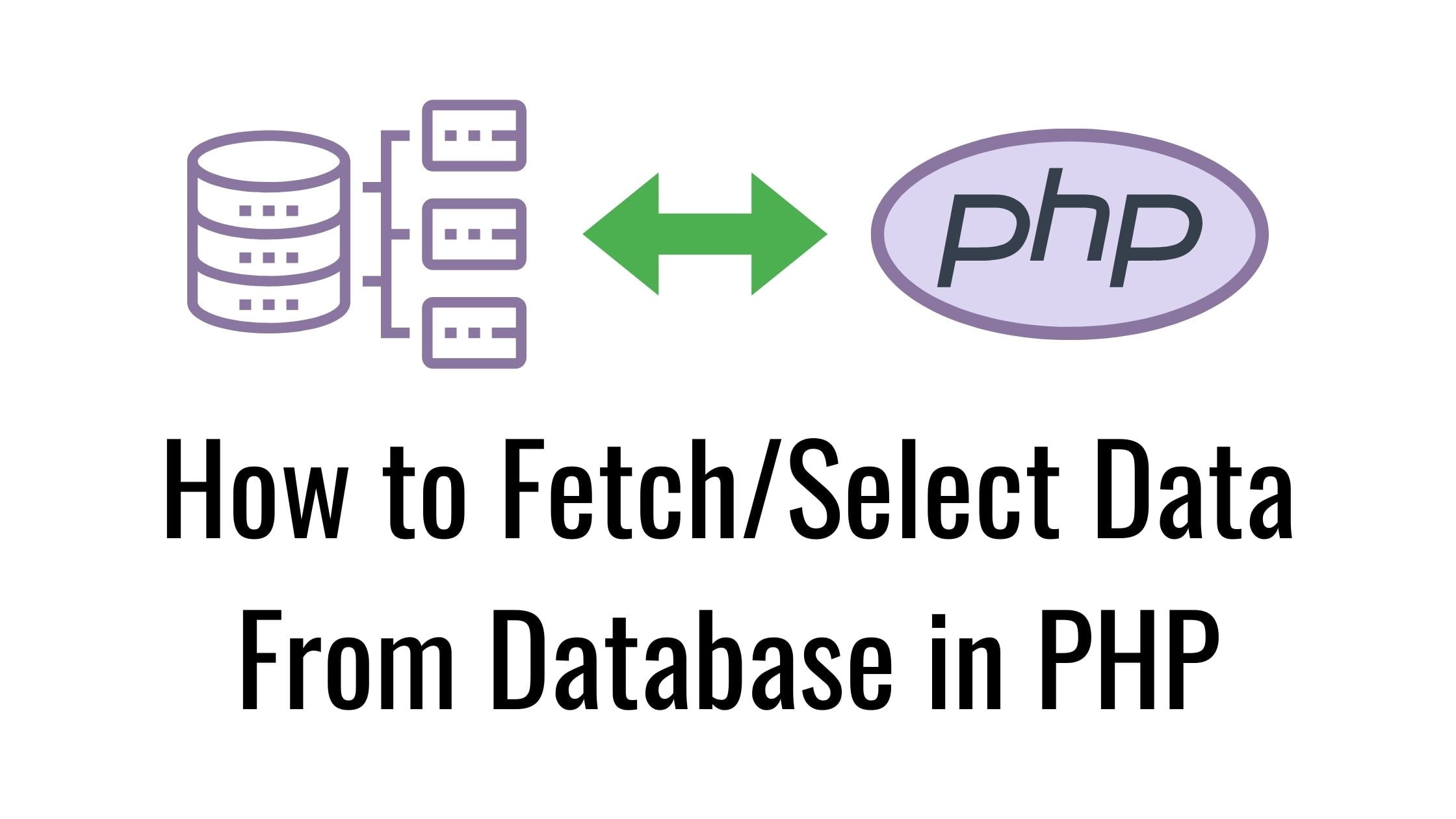As we know Database is a collection of tables that store data in it.
To retrieve or fetch data from the MySQL database, it is simple to do it using MySQL ” Select ” query in PHP.
Here in this blog post, we will see how to fetch data and display it in the front end.
Fetch Data From a MySQL Database
The SELECT statement is used to select data from one or more tables:
SELECT column_name(s) FROM table_name
or we can use the * character to select ALL columns from a table:
SELECT * FROM table_name
Fetching Data With MySQLi
The following example selects the id, firstname, and lastname columns from the MyGuests table and displays them on the page:
Example (MySQLi Object-oriented) Fetching Data With MySQLi
<?php
$servername = "localhost";
$username = "username";
$password = "password";
$dbname = "myDB";
// Create connection
$conn = new mysqli($servername, $username, $password, $dbname);
// Check connection
if ($conn->connect_error) {
die("Connection failed: " . $conn->connect_error);
}
$sql = "SELECT id, firstname, lastname FROM MyGuests";
$result = $conn->query($sql);
if ($result->num_rows > 0) {
// output data of each row
while($row = $result->fetch_assoc()) {
echo "id: " . $row["id"]. " - Name: " . $row["firstname"]. " " . $row["lastname"]. "<br>";
}
} else {
echo "0 results";
}
$conn->close();
?>Code lines to explain from the example above:
First, we set up an SQL query that selects the id, firstname, and lastname columns from the MyGuests table. The next line of code runs the query and puts the resulting data into a variable called $result.
Then, the function num_rows() checks if there are more than zero rows returned.
If there are more than zero rows returned, the function fetch_assoc() puts all the results into an associative array that we can loop through. The while() loop loops through the result set and output the data from the id, firstname, and lastname columns.
The following example shows the same as the example above, in the MySQLi procedural way:
Example (MySQLi Procedural) Fetching Data With MySQLi
<?php
$servername = "localhost";
$username = "username";
$password = "password";
$dbname = "myDB";
// Create connection
$conn = mysqli_connect($servername, $username, $password, $dbname);
// Check connection
if (!$conn) {
die("Connection failed: " . mysqli_connect_error());
}
$sql = "SELECT id, firstname, lastname FROM MyGuests";
$result = mysqli_query($conn, $sql);
if (mysqli_num_rows($result) > 0) {
// output data of each row
while($row = mysqli_fetch_assoc($result)) {
echo "id: " . $row["id"]. " - Name: " . $row["firstname"]. " " . $row["lastname"]. "<br>";
}
} else {
echo "0 results";
}
mysqli_close($conn);
?>You can also put the result in an HTML table:
Example (MySQLi Object-oriented)
<?php
$servername = "localhost";
$username = "username";
$password = "password";
$dbname = "myDB";
// Create connection
$conn = new mysqli($servername, $username, $password, $dbname);
// Check connection
if ($conn->connect_error) {
die("Connection failed: " . $conn->connect_error);
}
$sql = "SELECT id, firstname, lastname FROM MyGuests";
$result = $conn->query($sql);
if ($result->num_rows > 0) {
echo "<table><tr><th>ID</th><th>Name</th></tr>";
// output data of each row
while($row = $result->fetch_assoc()) {
echo "<tr><td>".$row["id"]."</td><td>".$row["firstname"]." ".$row["lastname"]."</td></tr>";
}
echo "</table>";
} else {
echo "0 results";
}
$conn->close();
?>Fetching Data With PDO (+ Prepared Statements)
The following example uses prepared statements.
It selects the id, firstname, and lastname columns from the MyGuests table and displays it in an HTML table:
Example (PDO) Fetching Data With PDO
<?php
echo "<table style='border: solid 1px black;'>";
echo "<tr><th>Id</th><th>Firstname</th><th>Lastname</th></tr>";
class TableRows extends RecursiveIteratorIterator {
function __construct($it) {
parent::__construct($it, self::LEAVES_ONLY);
}
function current() {
return "<td style='width:150px;border:1px solid black;'>" . parent::current(). "</td>";
}
function beginChildren() {
echo "<tr>";
}
function endChildren() {
echo "</tr>" . "\n";
}
}
$servername = "localhost";
$username = "username";
$password = "password";
$dbname = "myDBPDO";
try {
$conn = new PDO("mysql:host=$servername;dbname=$dbname", $username, $password);
$conn->setAttribute(PDO::ATTR_ERRMODE, PDO::ERRMODE_EXCEPTION);
$stmt = $conn->prepare("SELECT id, firstname, lastname FROM MyGuests");
$stmt->execute();
// set the resulting array to associative
$result = $stmt->setFetchMode(PDO::FETCH_ASSOC);
foreach(new TableRows(new RecursiveArrayIterator($stmt->fetchAll())) as $k=>$v) {
echo $v;
}
} catch(PDOException $e) {
echo "Error: " . $e->getMessage();
}
$conn = null;
echo "</table>";
?>If you like this piece of content, please support via comments.

